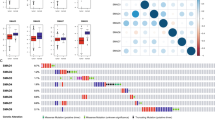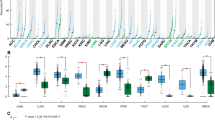Abstract
Background
Breast cancer (BRCA) is one of the most common malignant tumors. The structural maintenance of chromosome (SMC) gene family has been shown to play an important role in human cancers. However, the role of SMC families in BRCA is unclear. This study aimed to explore the role and potential clinical value of whole SMCs in BRCA.
Methods
TIMER and UALCAN database were used to analysis the expression level. Genetic variations were analyzed by cBioPortal. Promoter methylation and protein level were analyzed by UCLCAN. GO and KEGG were analyzed by Metascape database. Prognostic value of SMCs was analyzed by Kaplan–Meier and multivariate cox regression analyses. Immune infiltration analysis was conducted by CIBERSORT. Immunotherapy outcome prediction was conducted by Cancer Immunome Atlas. Targeted drug therapy outcome prediction was taken by GDSC and R language. The cell viability was tested by CCK8 and migration was tested by wound healing assay. Xenograft model was used to investigate the in vivo role of SMC2.
Results
Expression levels of SMC1A, SMC2, SMC4, SMC5 and SMC6 mRNA were increased in BRCA tissues, and negatively correlated with promoter methylation. Overexpression of SMC2 and SMC4 was negatively correlated with survival. Function of SMCs family regulatory genes was mainly related to ATPase activity. Expression of most SMCs was negatively correlated with immunotherapy and drug therapy outcomes. Interfere SMC2 and SMC4 decreased IC50 values of 5-fluorouracil and oxaliplatin and inhibited the migration of MCF7 cells. Tumor growth and weights were significantly decreased in si-SMC2 groups.
Conclusions
Combined bioinformatics and clinical specimen analysis verified SMC2 and SMC4 as independent prognostic factors in BRCA, suggesting their significance for the diagnosis and treatment of BRCA.








Similar content being viewed by others
Availability of data and materials
The data comes from TCGA (https://portal.gdc.cancer.gov/) public database.
References
Wormann B. Breast cancer: basics, screening, diagnostics and treatment. Med Monatsschr Pharm. 2017;40(2):55–64.
Cejuela M, Vethencourt A, Pernas S. Immune checkpoint inhibitors and novel immunotherapy approaches for breast cancer. Curr Oncol Rep. 2022;24(12):1801–19.
Chen W, Zheng R, Baade PD, Zhang S, Zeng H, Bray F, Jemal A, Yu XQ, He J. Cancer statistics in China, 2015. CA Cancer J Clin. 2016;66(2):115–32.
Zheng RS, Zhang SW, Sun KX, Chen R, Wang SM, Li L, Zeng HM, Wei WW, He J. Cancer statistics in China, 2016. Zhonghua Zhong Liu Za Zhi. 2023;45(3):212–20.
Gonzalez-Angulo AM, Morales-Vasquez F, Hortobagyi GN. Overview of resistance to systemic therapy in patients with breast cancer. Adv Exp Med Biol. 2007;608:1–22.
Losada A, Hirano T. Dynamic molecular linkers of the genome: the first decade of SMC proteins. Genes Dev. 2005;19(11):1269–87.
Nishiwaki T, Daigo Y, Kawasoe T, Nagasawa Y, Ishiguro H, Fujita M, Furukawa Y, Nakamura Y. Isolation and characterization of a human cDNA homologous to the Xenopus laevis XCAP-C gene belonging to the structural maintenance of chromosomes (SMC) family. J Hum Genet. 1999;44(3):197–202.
Li J, He J, Wang Y, Shu Y, Zhou J. SMC1 promotes proliferation and inhibits apoptosis through the NF-κB signaling pathway in colorectal cancer. Oncol Rep. 2019;42(4):1329–42.
Vincent A, Herman J, Schulick R, Hruban RH, Goggins M. Pancreatic cancer. Lancet. 2011;378(9791):607–20.
Dávalos V, Súarez-López L, Castaño J, Messent A, Abasolo I, Fernandez Y, Guerra-Moreno A, Espín E, Armengol M, Musulen E, et al. Human SMC2 protein, a core subunit of human condensin complex, is a novel transcriptional target of the WNT signaling pathway and a new therapeutic target. J Biol Chem. 2012;287(52):43472–81.
Zhou B, Chen H, Wei D, Kuang Y, Zhao X, Li G, Xie J, Chen P. A novel miR-219-SMC4-JAK2/Stat3 regulatory pathway in human hepatocellular carcinoma. J Exp Clin Cancer Res. 2014;33(1):55.
Jiang L, Zhou J, Zhong D, Zhou Y, Zhang W, Wu W, Zhao Z, Wang W, Xu W, He L, et al. Overexpression of SMC4 activates TGFbeta/Smad signaling and promotes aggressive phenotype in glioma cells. Oncogenesis. 2017;6(3): e301.
Ma RM, Yang F, Huang DP, Zheng M, Wang YL. The prognostic value of the expression of SMC4 mRNA in breast cancer. Dis Markers. 2019;2019:2183057.
Emens LA. Breast cancer immunotherapy: facts and hopes. Clin Cancer Res. 2018;24(3):511–20.
Acknowledgements
We thank all our colleagues in the laboratory for their assistance during the progression of this study. We acknowledge all the public database used in this study for providing their platforms and contributors for uploading their meaningful datasets.
Funding
This study was supported by grants from the National Natural Science Foundation of China [81703557], Science and Technology Development Fund of Nanjing Medical University (KDNMUB202201), Research and Development Fund of Kangda College of Nanjing Medical University (KD2022KYJJYB013), Kangda College of Nanjing Medical University "Scientific Research Talent Training Program"(KD2021KYRC019), and Innovation and Entrepreneurship Training Program for College Students in Jiangsu Province (KD2023SJCXCY21, KD2023SJCXCY22).
Author information
Authors and Affiliations
Contributions
Lili Pei, WenhaoWu, and Siyi Fan: Collected data, conducted the data summary and statistical analysis. Yu Li and Hao Gu: performed experiments and searched for references and helped to write and revise the paper. Xiao Shi: Conducted data analysis and interpretation and wrote the manuscript. Xinxin Si: Assembled data and reviewed the manuscript. All authors contributed to the article and approved the submitted version.
Corresponding authors
Ethics declarations
Conflict of interests
The authors declare that they have no competing interests.
Consent for publication
Not applicable.
Additional information
Publisher's Note
Springer Nature remains neutral with regard to jurisdictional claims in published maps and institutional affiliations.
Rights and permissions
Springer Nature or its licensor (e.g. a society or other partner) holds exclusive rights to this article under a publishing agreement with the author(s) or other rightsholder(s); author self-archiving of the accepted manuscript version of this article is solely governed by the terms of such publishing agreement and applicable law.
About this article
Cite this article
Pei, L., Li, Y., Gu, H. et al. Identification of SMC2 and SMC4 as prognostic markers in breast cancer through bioinformatics analysis. Clin Transl Oncol (2024). https://doi.org/10.1007/s12094-024-03521-5
Received:
Accepted:
Published:
DOI: https://doi.org/10.1007/s12094-024-03521-5




